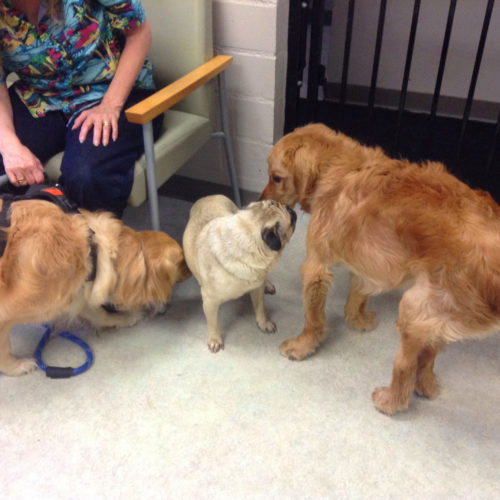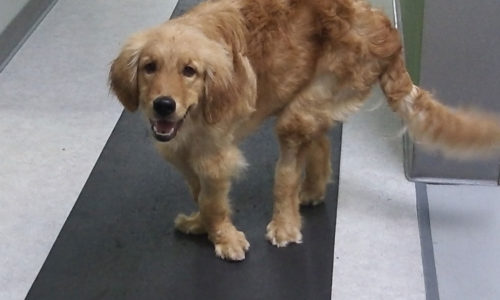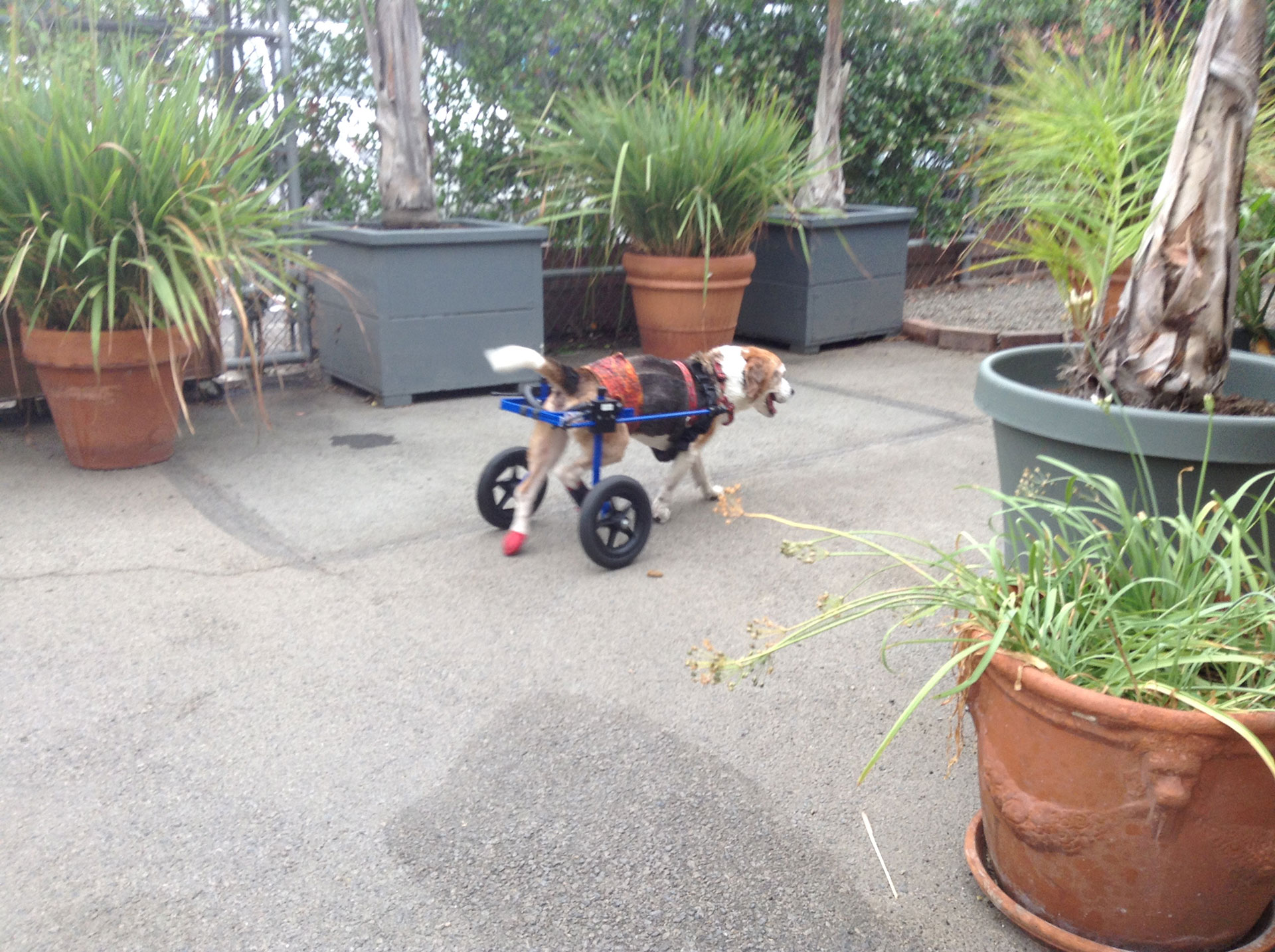Chapter 8
By Leslie Gallagher
The weeks after Maverick’s first steps were absolutely exhausting. As if we weren’t tired enough already! Maverick REALLY wanted to get up and greet people, get up and meet dogs and “help” with their therapy, especially when therapy meant lamb-flavored treats being handed out for jobs well done. He figured he’d done a darn good job just getting up and waddling over to them and that, of course, must mean a treat! Hilariously, he started to become a bit of a pain as he was constantly trying to get to his feet and help with someone’s therapy. It truly was easier when he wasn’t able to move! I didn’t have to worry about him getting in the way, getting bit, or walking on his upside down feet.


Each day his feet got SLIGHTLY better and over the next few weeks we were constantly being congratulated by shocked clients who couldn’t believe he could get up, much less walk! It was a crooked, crazy, drunken puppy kind of walk, but he was mobile! I sometimes had to stop and reflect on our success as I was so obsessed (and stressed) with making sure each footstep was straight and proper. In less than three months we had gotten him to stand. And now, after just over four months he was walking and oh, so hilariously, trying to run.
In our business we face a constant struggle of getting paralyzed dogs to walk again. Some owners and many, many vets give an animal very little time before saying that a “tough decision” has to be made. It’s insanely frustrating because we know that, statistically, 80% of all paralyzed dogs will walk again. I remember years ago my very own vet (who obviously isn’t my vet anymore) told me that he “didn’t believe” in down dogs and thought they all should be euthanized. I was blown away. And kept thinking of the dozens upon dozens of dogs I’ve seen over the years that were insanely happy running around in their wheelchairs.
Aside: after I lost Sophie, the love of my life and my first paralyzed German Shepherd I went to German Shepherd Rescue in Burbank and asked the owner, Grace, if she had any paralyzed GSD’s. In fact she did! She brought out Skye, the goofiest old lady whose owners had dropped her at the rescue after she had become paralyzed. I told her that I’d take her and Grace handed me her leash. I said, “Grace!! You can’t just give me this dog!! You haven’t even read my application! What if I’m planning on selling her for medical research or using her as a bait dog?? You haven’t done a home check!” to which she responded, “In my line of work and having done this for so many years, I know when the right home comes along. I know you will take good care of this old girl”, and of course she was right.
I adored that crazy Shepherd. I got her walking as best she could but we always used a wheelchair for walking around the neighborhood. Skye went through the roof when I pulled out her wheels and asked, “Wanna go for a walk?” She was a complete maniac in those wheels. I also found out the hard way that she was dog aggressive (who knew!!!) as one day she saw a dog at the end of the block and took off like a bat out of hell in her wheelchair. Me, who runs six miles a day and happened to even be wearing my running shoes could not catch her!!!! I was mortified when I finally caught up to her and she’d already taken a nice chomp out of a Schnauzer’s head. Bryan and I always felt like she was truly one of the happiest dogs we had ever known. Even at the end of her life when she had ruptured multiple new discs and could barely move, she was thrilled to get in her wheels and take off. She also had this habit of lying in her dog bed, in the driveway, in plain sight. For some reason, though, she thought she was invisible. As we would walk by, for any reason, she would spring up as if to say “SURPRISE!” Gotta love GSDs.
So, when people want to euthanize a dog because “it can’t walk” or vets tell their clients just to put the dog down without even trying alternatives, it gets my hackles up. You would never ask the parents of a child who was hit by a car while riding her bike and became paralyzed, “So, you going to put her down??” Of course not. You’d do everything possible to help that child learn to walk again. And especially if you told her parents that with intensive, hard rehab they would probably be walking in six months. Would humans take that deal?? Hell yes. Is it expensive? Yes. Take a lot of time? Uh, huh. Frustrating? You bet. Are there setbacks? Yep. But you’d do it. I doubt anyone would say, “No, please just call Jack Kevorkian.” Our paralyzed dogs want to walk just as badly as we want them to. And most of them do if we give them the chance. I would never say that it’s easy because it’s not. But the dogs that get better come to us, work really hard and stick with it until they are up again. I could cite a thousand examples of dogs that boarded with us that left our facility practically running.
We recently had a big Labradoodle that had a stroke. His prognosis was terrible. His owner was devastated as he was paralyzed at only 5 yrs old. I told her to leave the dog with us and check back on a regular basis. It took a long time, maybe five weeks of intensive therapy and exasperatingly slow progress but he recently walked into the building. Cheers all around!!! Now that he is back home and not coming for regular therapy his progress has definitely slowed which is frustrating but not everyone can afford the time, $$ and energy that it takes to get these pups the intensive therapy that they sometimes need.
We also had another Rottie/Shepherd mix that had suffered a stroke. Her owners brought her in five days a week. It’s been a bit over a month now and she is walking beautifully. When you think of professional athletes that have an ACL repair or a disc repair you know they don’t go to therapy once or twice a week or whenever it’s convenient. Oh, no. They are in the training/rehab facility every single day using all the latest modalities and equipment to get better as soon as possible. This is one of the reasons I like to board dogs post-surgery or post-accident. They get daily, hourly, constant rehab with our therapists and our equipment. And they recover the quickest with the least setbacks. Those are the true success stories.
We currently are boarding and rehabbing an older Basset Hound that ruptured just about every disk in his back. His owners spent a small fortune on surgery and knew that they could not care for him post-op as he is huge, heavy, crabby and not urinating on his own. I’m actually really glad that they have left him with us. His case was so bad I did not want to have one of those “We need to make a tough decision” conversations, which I knew we’d have if they took him home and tried to manage him on their own. It’s just too hard. Luckily we are good at it and he’s been with us about a month now. He started making small gains after a few days and he began to walk, oddly,(with both back legs tucked straight underneath him pointing at his elbows) at week three. Now, at week four he’s in his own wheelchair and using both back legs pretty well. It’s going to be awhile for him as he had so many bad discs, but if he hadn’t boarded with us I can guarantee he wouldn’t be walking now, such as it is. He might not even be alive. In a few more weeks he will go home and will be just fine. Probably still crabby, though. A sad update: By week six the Basset Hound had continued to make progress and could almost stand up on his own. He could walk with minimal assistance when one of our techs sat on a dolly and followed him around the building. He could empty about half of his bladder himself and was very good about letting us empty the rest for him. (Not always the case!) He still had issues with pooping in large part because he couldn’t yet stand up to relieve himself. He was in great spirits despite being bossy. He would always poop when his owners came for a visit because he was so happy and excited. We felt that with two or three more weeks of intensive therapy he would have been getting up on his own and walking with little or no assistance. But the owners decided it was time for him to go home. We spent a long, long time with them explaining his needs, how to get him in his cart, how to express a bladder, and how to walk him. We strongly recommended they continue his daily therapy. He had made incredible progress almost daily. Never a setback. The Basset went home. He was put down the next day.

